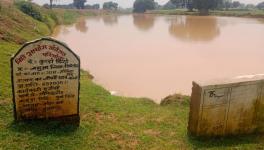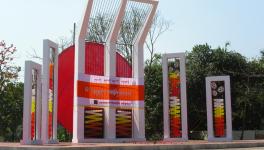Most Devastating Floods in Bangladesh in 122 years
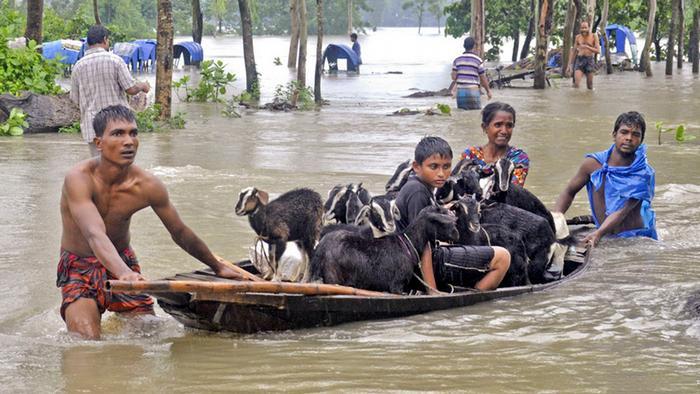
At least, 25 people have been killed and four million stranded in floods in Bangladesh.
At least, 64 upazilas (subdistricts) of 10 districts in northern and southern Bangladesh, including Sunamganj and Sylhet, and the northeast, including Habiganj and Netrokona, northeast have reached an extreme level of flood danger.
At least, 25 people have been killed more than four million stranded in the floods, caused by incessant rains in the last week, with the Army, Coast Guard and the Navy evacuating people.
The floods have already inundated 90% of Sunamganj and 80% of Sylhet and Habiganj. State minister for disaster management and relief Enamur Rahman told reporters that these are the most devastating floods in Sylhet and Sunamganj in the last 122 years.
The situation is also deteriorating in Lalmonirhat, Nilphamari, Rangpur, Kurigram, Jamalpur and Sherpur districts in the northwest part of the country. According to the Flood Forecasting Centre, 17 more districts in the north and central parts of the country could be flooded in the next two days.
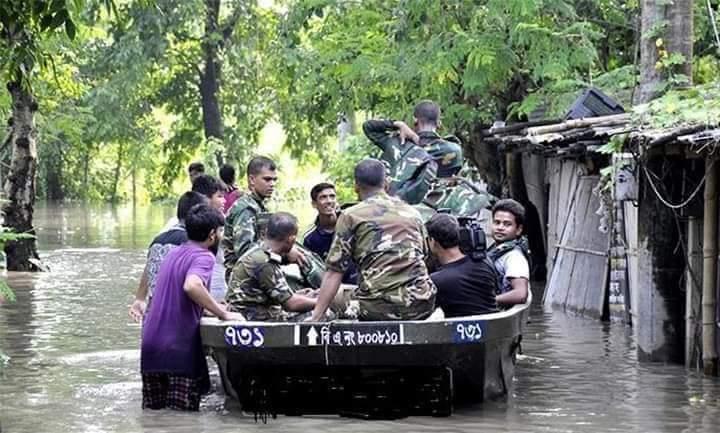
The Army, Coast Guard and the Navy have been deployed to evacuate people.
Meanwhile, the Jamuna River is rising alarmingly due to steep slopes and heavy water flowing down from the upper reaches. The chars and lowlands of the river are already flooded.
The situation in the northwest and central districts is deteriorating with the Teesta River overflowing seven centimetres above the danger zone.
The Centre for Flood Forecasting and Warning has said that all the major rivers are rising with 18 points of 9 rivers flowing above the danger mark—Brahmaputra, Jamuna, Dharla, Teesta, Dudhkumar, Surma, Kushiyara, Ghaghat and Someshwari. The low-lying areas of Tangail, Munshiganj and Shariatpur districts could be inundated anytime.
According to the meteorological agency’s mathematical model forecast, moderate-to-heavy rainfall is expected in the north, northeast, the foothills of Assam, Meghalaya and Himalayan foothills of West Bengal in the next 48 hours.
As a result, the level of all major rivers, including Brahmaputra-Jamuna, Ganga-Padma, Surma, Kushiyara, Teesta, Dharla and Dudhkumar may continue to rise in the next 48 hours. It is feared that the flood situation in the northeast districts of Sylhet, Sunamganj and Netrokona may worsen during this time.
The ministry of disaster management and relief has allocated 80 lakh taka (BTD) and 26,000 packets of dry food to affected families in Sylhet, Sunamganj, Netrokona, Kurigram, Rangpur and Nilphamari. Each food packet, containing rice, pulses, oil, salt and sugar, is expected to last a week for a family of five. Besides, 300 tonnes of rice have been provided to the flood-hit families.
Besides, Several political parties, student, youth and voluntary organisations and NGOs are assisting the affected people. Celebrities from different walks of life are also helping in relief work and raising funds.
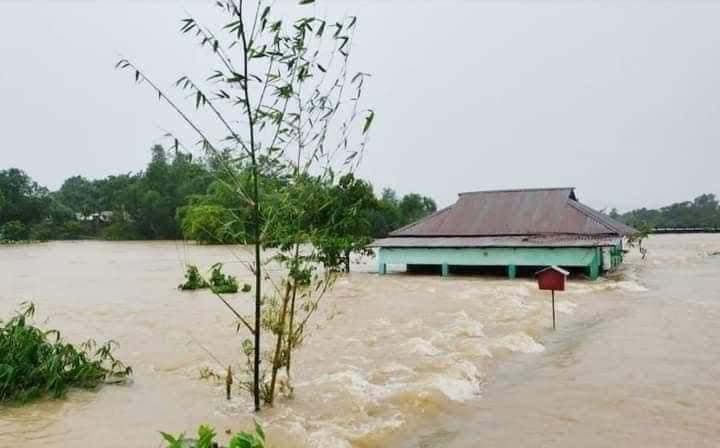
River researchers in Bangladesh have said that the heavy rains in Assam and Meghalaya are a major reason for the flash floods.
Reasons for the devastating floods
River researchers have said that the heavy rains in Assam and Meghalaya are a major reason for the flash floods. Excess rainwater from Meghalaya or Assam flows into the Bay of Bengal via Meghna or Jamuna. But this time, the excess water coming from the upper reaches could not flow due to the sudden flood due to the reduced navigability of the rivers.
Professor AKM Saiful Islam, director, Institute of Flood and Water Management, Bangladesh University of Engineering and Technology, said that the soil loosens and flows into the rivers especially due to the uplift of rocks upstream of India. As a result, the bottom of the rivers is filled, preventing navigability. Besides, insufficient dredging fills the river bed with garbage and the wetlands as a result of urbanisation.
Islam also pointed out some man-made reasons. “We have built roads in different places in Haor, obstructing the water flow. Therefore, floods are occurring in advance.” Several social media posts have blamed the construction of the Itna-Mithamin road, in Kishoreganj district, for the repeated floods in Sylhet.
Despite strict directives from Prime Minister Sheikh Hasina last January that only elevated roads should be constructed in Haor, most of them are ‘all season’ or ‘submersible’ roads.
The lack of damns in Sylhet, Sunamganj, Kishoreganj or Netrokona Haor areas is another reason for the floods. If the water in Haor or a river starts to rise, it quickly enters towns or residential areas. There are no dams in Bagerhat and Satkhira areas of Khulna division as well.
“If damns were not constructed, houses should have been constructed at a higher elevation. That too was not done. As a result, when such flash floods occur, the damage is much greater,” Islam added.
Get the latest reports & analysis with people's perspective on Protests, movements & deep analytical videos, discussions of the current affairs in your Telegram app. Subscribe to NewsClick's Telegram channel & get Real-Time updates on stories, as they get published on our website.











